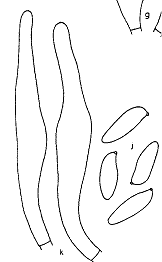|
 Xerocomus chrysenteron Xerocomus chrysenteron
SynonymsBoletus chrysenteron
BiostatusPresent in region - Exotic
Images (click to enlarge)
Caption: FIG. 1 X. chrysenteron: j, spores; k. cystidia. |
Article: McNabb, R.F.R. (1968). The Boletaceae of New Zealand. New Zealand Journal of Botany 6(2): 137-176 (http://www.rsnz.org/publish/abstracts.php).
Description: PILEUS: convex
when young, becoming plano-convex to applanate at maturity, 4-8 cm diam., dry,
subglabrous, felted or subtomentose, coffee brown, chestnut brown, yellow-brown
or greyish fawn, irregularly creviced at maturity, crevices pink to red; cuticle
a trichodermium composed of erect, septate, often roughened hyphae 5.5-10 µm
diam., with pallid brown contents; margin entire, HYMENOPHORE: tubes to 10mm
long, excavated around apex of stipe, sulphur yellow at first, becoming greenish
yellow at maturity; pores concolorous with tubes, irregularly angular, 0.75-1.5
mm diam.; bluing where damaged. STIPE: 3.5-8 cm long, equal or more often tapering
basally, 7-18 mm diam., solid, fibrous, dry, slightly longitudinally grooved,
pallid yellow with scarlet or crimson streaks particularly at base; flesh red
basally; annulus absent.
SPORES: spore print
olive brown (Orange-Citrine); spores melleous, subfusiform, 11.7-14.5-(17.2)
X 4.1-5.4 µm, smooth. HYMENIUM: basidia hyaline, clavate, 34-9 X 9.2-13 µm,
4-spored; cystidia abundant, scattered, hyaline to pallid melleous, thin-walled,
ventricose-rostrate to narrowly lageniform, 45-70 X 8-10.5 µm. HYMENOPHORAL
TRAMA: bilateral, of the Phylloporus subtype; clamp connections absent. CONTEXT
OF PILEUS: white to pallid yellow, pink to reddish immediately beneath cuticle,
rapidly bluing on exposure to air. TASTE: mild. SMELL: not distinctive.
Habitat: HABITAT : Gregarious under introduced broadleaved trees.
Notes: Xerocomus chrysenteron is an introduced species, which is widely distributed
throughout temperate regions of the northern hemisphere. In its native environment
it occurs under both coniferous and broadleaved trees. There are conflicting
reports in the literature as to the edibility of this species and it appears
that it is not highly esteemed as an edible fungus.
X. chrysenteron may be distinguished by the dry, irregularly creviced
pileus which shows a red or pink colour in the crevices, red streaked stipe,
and hymenophore which rapidly turns blue where damaged. It has not previously
been recorded from New Zealand.
|